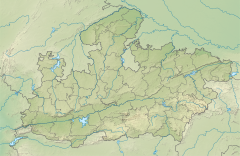| Bateshwar Hindu temples | |
|---|---|
 A few of the 200 Hindu temples in Batesvar | |
| Religion | |
| Affiliation | Hinduism |
| District | Morena district |
| Deity | Shiva, Vishnu, Devi, others |
| Location | |
| Location | Padavali, Chambal Valley |
| State | Madhya Pradesh |
| Country | India |
| Geographic coordinates | 26°25′37.4″N 78°11′48.6″E / 26.427056°N 78.196833°E |
| Architecture | |
| Style | Nagara |
| Completed | 8th to 11th-century, during Gurjara-Pratihara Empire[1] |
The Bateshwar Hindu temples (romanised: baṭeśvar; /bəʈeːɕvər/) are a group of nearly 200 sandstone Hindu temples and their ruins in north Madhya Pradesh in post-Gupta, early Gurjara-Pratihara style of North Indian temple architecture.[1] It is about 35 kilometres (22 mi) north of Gwalior and about 30 kilometres (19 mi) east of Morena town. The temples are mostly small and spread over about 25 acres (10 ha) site. They are dedicated to Shiva, Vishnu and Shakti - representing the three major traditions within Hinduism. The site is within the Chambal River valley ravines, on the north-western slope of a hill near Padavali known for its major medieval era Vishnu temple. The Bateshwar temples were built between the 8th and the 10th-century.[1] The site is likely named after the Bhuteshvar Temple, the largest Shiva temple at the site. It is also referred to as Batesvar temples site or Batesara temples site.[2][3]
The temples as they now appear are in many cases reconstructed from the fallen stones in a project begun by the Archaeological Survey of India in 2005. Dacoit Nirbhay Singh Gujjar and his gang helped Archaeological Survey of India restore the temple complex.
According to the Madhya Pradesh Directorate of Archaeology, this group of 200 temples were built during the reign of Gurjara-Pratihara Dynasty.[4] According to Michael Meister, an art historian and a professor specializing in Indian temple architecture, the earliest temples in the Bateshwar group near Gwalior are likely from the 750-800 CE period.[5] Cunningham reports that one of the inscriptions was dated Samvat 1107 or 1050 AD.[6]
The temples were destroyed after the 13th century; it is not clear if this was by an earthquake.[1]
- ^ a b c d Subramanian, T.S. (16–29 January 2010). "Restored Glory". Frontline, Volume 27 – Issue 02. Retrieved 17 January 2010.[permanent dead link]
- ^ Cite error: The named reference
Mevissen2012p95was invoked but never defined (see the help page). - ^ Cite error: The named reference
viennotwas invoked but never defined (see the help page). - ^ Madhya Pradesh (India)-Directorate of Archaeology & Museums (1989). Puratan, Volumes 6–7. Dept. of Archaeology and Museums, Madhya Pradesh. p. 113.
- ^ Michael W. Meister (1976), Construction and Conception: Maṇḍapikā Shrines of Central India, East and West, Vol. 26, No. 3/4 (September - December 1976), page 415, Figure 21 caption, context: 409-418
- ^ Cite error: The named reference
cunningham107was invoked but never defined (see the help page).

